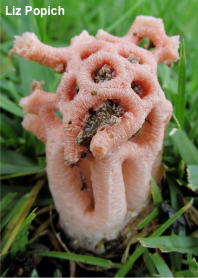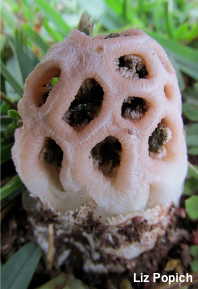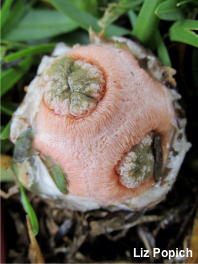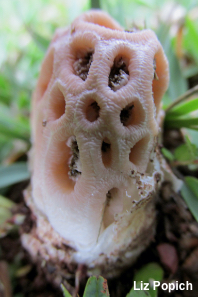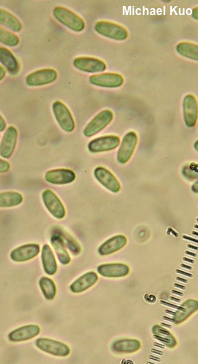| Major Groups > Stinkhorns > Clathrus transvaalensis |

|
Clathrus transvaalensis [ Basidiomycota > Agaricomycetes > Phallales > Clathraceae > Clathrus . . . ] by Michael Kuo Known from South Africa, this awesome stinkhorn was first described by mycologists who found its "eggs" on a golf course and, worried that golfers would trample the specimens before they matured, brought the eggs to a lab for "incubation" under moist paper towels. When the mature stinkhorns emerged, the mycologists determined that the little guys were not adequately accounted for in stinkhorn literature—so they described a new species (Eicker & Reid 1990). Clathrus transvaalensis can be recognized by its pinkish colors, its range (it appears, so far, to be limited to southern Africa), and the fact that it produces its spore slime on little cushion-shaped bumps located at the intersections of the arms, which form polygonal spaces in a meshed structure. Thanks to Liz Popich for documenting, collecting, and preserving Clathrus transvaalensis for study; her collection is deposited in The Herbarium of Michael Kuo. Description: Ecology: Saprobic; growing alone or gregariously in urban locations, including lawns and golf courses as well as other cultivated areas, and in woodchip beds; January through April; South Africa. The illustrated and described collection is from Gauteng, South Africa. Immature Fruiting Body: Like a whitish to pinkish or brownish "egg"; when sliced revealing the stinkhorn-to-be encased in a gelatinous substance. Mature Fruiting Body: 5–10 cm high; 4–7 cm wide; consisting of a mesh of arms, with the lower meshes elongated vertically (almost appearing like supporting columns) and the upper meshes smaller, creating roundish to polygonal spaces. Arms: Up to about 1 cm thick; hollow; outer surfaces sometimes slightly flattened; densely transversely wrinkled (accordion-like in appearance); grooved between meshes; creamy whitish (especially below) to pinkish or pale salmon. Volva: Sac-like, encasing the base of the fruiting body; whitish to pinkish, with brownish stains. Flesh: Composed of tiny tubes; pinkish; brittle. Spore Slime: Brown; produced on cushion-shaped structures located at the intersections of the arms. Microscopic Features: Spores 4–5 x 1.5–2 µm; subcylindric; smooth; hyaline in KOH. Sphaerocysts of the arms 15–48 µm; irregularly subglobose; smooth; walls 0.5–0.75 µm thick; hyaline in KOH. Hyphae of the volva 2–4 µm wide unless swollen at septa (up to 7 µm); smooth; hyaline in KOH. REFERENCES: Eicker & D. A. Reid, 1990. (Coetzee, 2010; Lécuru et al., 2013) Herb. Kuo 03111401. This site contains no information about the edibility or toxicity of mushrooms. |
© MushroomExpert.Com |
|
Cite this page as: Kuo, M. (2019, December). Clathrus transvaalensis. Retrieved from the MushroomExpert.Com Web site: http://www.mushroomexpert.com/clathrus_transvaalensis.html |
